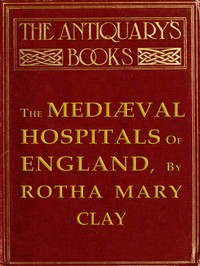The Mediæval Hospitals of England
Author: Rotha Mary Clay
Bookshelves: Culture/Civilization/Society, History - Medieval/The Middle Ages, Category: Health & Medicine, Category: History - British, Category: History - Medieval/Middle Ages

Summary
"The Mediæval Hospitals of England" by Rotha Mary Clay is a historical account written in the early 20th century. This work explores the significance and role of hospitals in medieval England, serving as institutions of care and charity for the sick, the helpless, and wayfarers during a time when public health infrastructure was rudimentary. The author aims to shed light on how these hospitals were integral to the social fabric of the Middle Ages, extending beyond mere medical assistance to embody a complete support system for the vulnerable populations. At the start of the narrative, the introduction outlines the vital yet underappreciated role that hospitals played throughout the medieval period. The author emphasizes that these institutions were not medical in nature, as modern readers might expect, but were largely ecclesiastical, focusing on spiritual care as well as physical sustenance for individuals in need. Various types of hospitals are pointed out, such as those for lepers, wayfarers, and the poor. Specific examples, like the establishment of the significant St. Bartholomew’s Hospital and St. Thomas’ in Canterbury, highlight the evolution of these hospitable refuges as they adapted to the changing societal needs of the time. This opening sets the stage for a deeper exploration into the complex histories and varying functions of medieval hospitals throughout England. (This is an automatically generated summary.)
 LibraryManager
LibraryManager